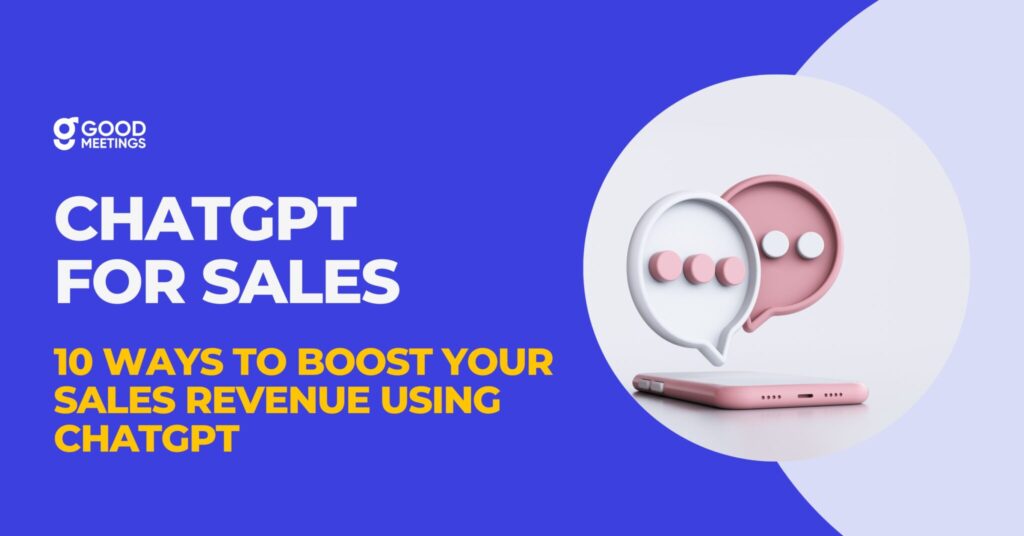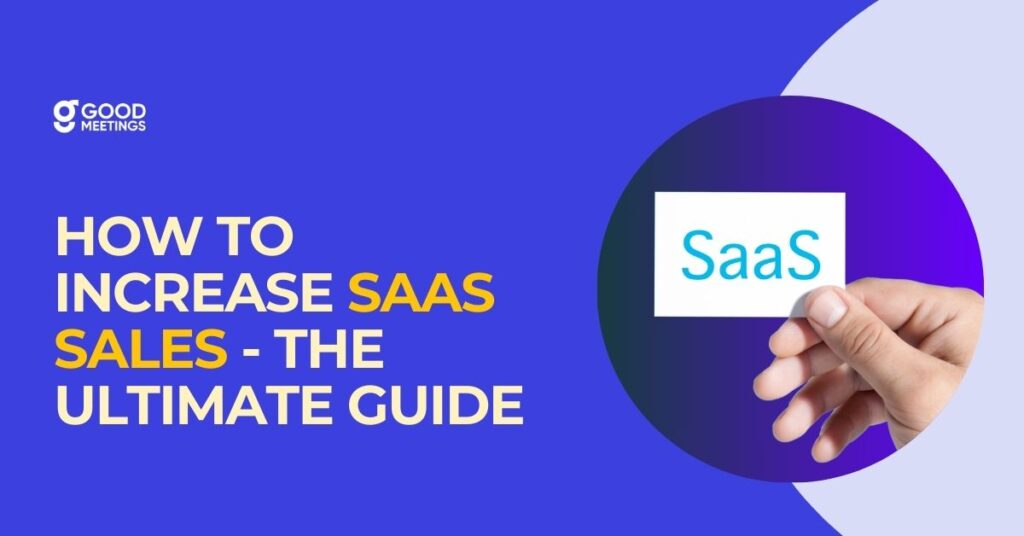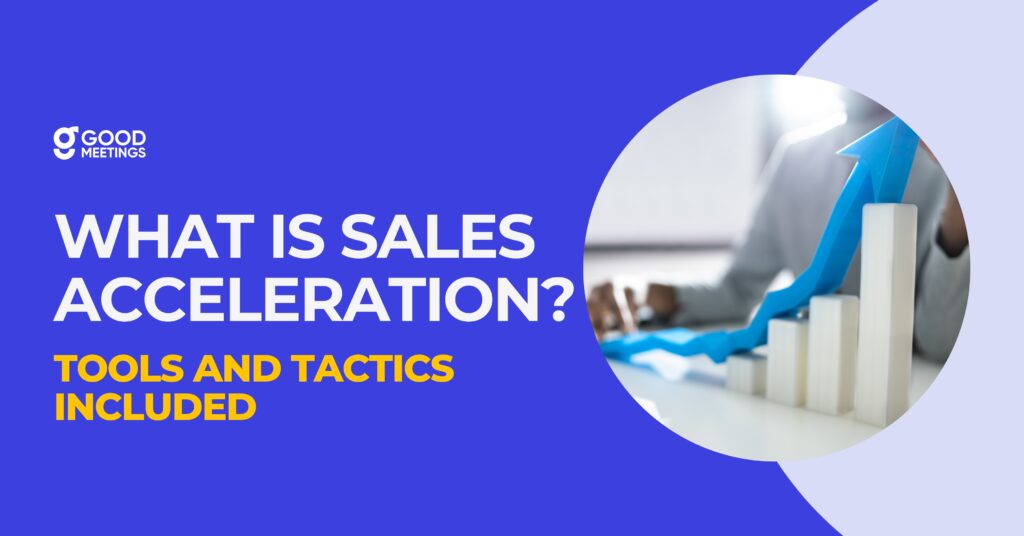Table of contents
- What is SaaS Sales?
- SaaS Sales vs. Regular Sales
- The Distinct Challenges of SaaS Sales
- Important SaaS Sales Metrics to Keep Track Of
- Key Elements of a Successful SaaS Sales Strategy
- How to Increase SaaS Sales – 15 Powerful SaaS Sales Tips
Let’s face it—selling SaaS solutions is tough, especially in such a competitive field.
Studies show that 90% of SaaS startups fall short of their sales goals and struggle to generate enough revenue.
But don’t worry, with the right strategies, you can beat the odds and increase your sales.
This ultimate guide will walk you through proven techniques to attract more customers and increase SaaS sales.
Let’s learn how to increase SaaS sales!
What is SaaS Sales?
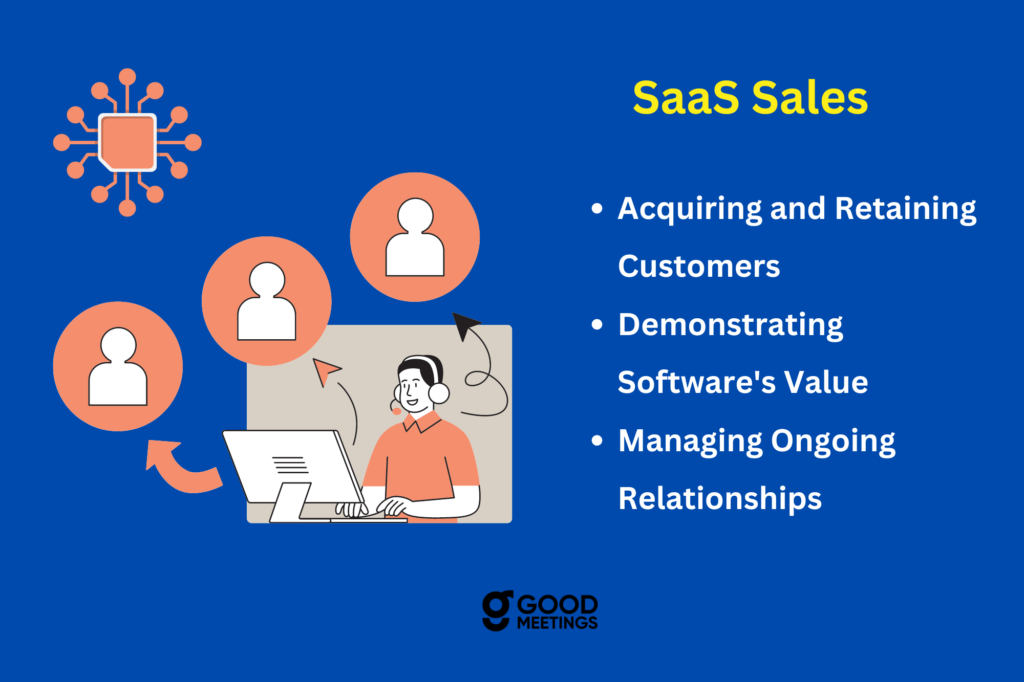
Source: Goodmeetings
SaaS sales refer to the process of selling Software as a Service (SaaS) products. SaaS is a cloud-based software delivery model where users access software via the internet, typically on a subscription basis.
Unlike traditional software, which is installed locally on devices, SaaS is hosted on remote servers and maintained by the provider. Enterprise SaaS sales involve,
- Acquiring and retaining customers
- Demonstrating the software’s value
- Managing ongoing relationships to ensure customer satisfaction and renewals
This sales model focuses on long-term customer engagement, often emphasizing customer support and regular updates to meet users’ evolving needs.
Related: SaaS Sales 101: Definition, Models & Best Practices
SaaS Sales vs. Regular Sales
SaaS sales focus on subscription-based, online software, with an emphasis on keeping customers long-term. Regular sales usually involve one-time purchases with limited ongoing interaction.
Here’s a table to help you understand the difference between the two:
| Features | SaaS Sales | Regular Sales |
| Payment Model | Subscription-based, monthly or yearly payments | One-time purchase or occasional renewals |
| Delivery Model | Online, accessed via the internet | Installed on local devices |
| Customer Relationship | Long-term focus, ongoing support and interaction | Short-term, one-time transaction |
| Revenue Model | Continuous, steady revenue stream | Upfront, less predictable income |
| Support & Updates | Regular updates and support included | Limited or separate support and updates |
| Sales Cycle | Often longer, includes demos and free trials | Usually shorter, based on product features |
| Customer Onboarding | Emphasis on training and setup | Focus on immediate purchase |
| Renewal Importance | High, crucial for growth | Less critical, depends on product need |
| Scalability | Easily scalable with low additional cost | Scaling may need significant extra resources |
Related: 20 Sales Meeting Ideas That Are Both Fun and Motivational
The Distinct Challenges of SaaS Sales
SaaS sales come with unique challenges that can make it tough to succeed. Here are some key challenges:
1. Customer Retention
Keeping customers satisfied and renewing their subscriptions is essential for ongoing revenue. It requires excellent customer service, continuous value addition, and prompt issue resolution to prevent churn.
2. Complex Sales Cycle
B2B SaaS sales involve a multi-stage process, including demos, trials, and negotiations with various stakeholders. Guiding potential customers strategically through these stages is crucial for conversion.
3. High Competition
The B2B SaaS market is crowded, making it challenging to differentiate products. Effective marketing, unique value propositions, and exceptional customer experiences are crucial to stand out in this competitive landscape.
4. Customer Education
SaaS products may be complex, requiring customers to adapt existing workflows. Educating them through comprehensive onboarding, training sessions, and accessible resources ensures maximum utilization of the software.
5. Consistent Updates
Regular updates and improvements are vital to meet customer expectations and remain competitive in the market. Responding to feedback and promptly addressing bugs helps maintain customer satisfaction and loyalty.
6. Pricing Pressure
Balancing competitiveness and profitability is challenging in SaaS sales. Companies need to experiment with pricing models and be flexible based on market feedback and customer needs.
7. Technical Issues
Ensuring seamless software functionality is crucial for customer satisfaction. A robust technical support team and proactive monitoring systems are essential to address any technical problems promptly and maintain reliability.
Related: 12 Sales Dashboard – Examples and Templates
Important SaaS Sales Metrics to Keep Track Of
Understanding key metrics is crucial for the success of any SaaS business. Below, we’ll explore four essential metrics you need to track to increase SaaS sales.
1. Conversions
Conversions measure the rate at which potential customers become paying customers. Conversions indicate how effective your sales and marketing efforts are in turning leads into paying customers.
Formula:
Conversion Rate = (Number of customers who purchase / Number of leads) x 100
Example:
If you have 500 leads in a month and 50 of them become paying customers, the conversion rate is (50/500) x 100 = 10%.
2. Churn Rate
Churn rate measures the percentage of customers who stop using your service over a specific period. It helps gauge customer retention and the overall health of your business.
Formula:
Churn Rate = (Number of customers lost in a given period / Total number of customers at the start of that period) x 100
Example:
If you have 1000 customers at the beginning of the month and 50 customers cancel their subscriptions during that month, the churn rate is (50/1000) x 100 = 5%.
3. MRR (Monthly Recurring Revenue)
MRR (Monthly Recurring Revenue) is the total predictable revenue generated from subscription fees in a month. It reflects the stability and growth potential of your business, making it attractive to investors.
Formula:
MRR = Total number of customers x Average monthly subscription fee
Example:
If you have 200 customers and each pays $50 per month, the MRR is 200 x $50 = $10,000.
4. CLV (Customer Lifetime Value)
CLV (Customer Lifetime Value) measures the total revenue a business can expect from a single customer over their entire relationship.
Understanding CLV helps in making decisions about customer acquisition costs, retention strategies, and overall business growth.
Formula:
CLV = Average purchase value x Purchase frequency x Customer lifespan
Example:
If the average purchase value is $100, the purchase frequency is 2 times per year, and the customer lifespan is 5 years, then CLV = $100 x 2 x 5 = $1000.
Related: 12 SaaS Sales Metrics You Should Care About in 2024
What is a SaaS Sales Strategy?
A SaaS sales strategy is a plan outlining how a company will attract, engage, and convert customers to its software-as-a-service (SaaS) product. It helps you to increase SaaS sales.
It involves identifying target markets, understanding customer needs, and creating a roadmap for selling and retaining customers.
Key components include,
- Effective marketing to generate leads
- Personalized sales approaches to address customer pain points
- Seamless onboarding process
The B2B SaaS sales strategy also focuses on building long-term relationships with customers through exceptional support and continuous value delivery.
Ultimately, a successful SaaS sales strategy is centered on meeting customer demands while achieving sustainable business growth.
Related: Sales Analytics 101: Definition, Tools and Metrics
Why SaaS Sales Strategy Is Important?
Want to know why B2C and B2B SaaS sales strategy is vital for the success of your business? Here’s are some reasons why:
1. Targeted Approach
A well-defined strategy helps focus efforts on the most promising customer segments. This increases the likelihood of successful conversions and optimizes resource utilization.
2. Efficient Resource Allocation
By identifying the most effective sales and marketing channels, resources can be allocated wisely. This maximizes return on investment (ROI) and reduces unnecessary expenses, ultimately leading to higher profitability.
3. Customer Engagement
A strategic approach ensures consistent and meaningful interactions with customers. This leads to higher satisfaction, increased loyalty, and positive word-of-mouth referrals, which are crucial for sustained business growth.
4. Competitive Advantage
Having a clear plan allows SaaS companies to differentiate themselves in a crowded market. This enables them to gain a competitive edge over rivals and position themselves as the preferred choice among potential customers.
5. Adaptability and Scalability
A flexible B2B SaaS sales strategy allows for adjustments based on market changes and business growth, ensuring long-term success and sustainability. It enables the company to respond quickly to evolving customer needs and scale operations effectively to meet increasing demand.
Related: 10 Best Sales Intelligence Software For 2024
Key Elements of a Successful SaaS Sales Strategy
Effective enterprise SaaS sales strategies are essential for driving growth and success in a competitive market. Below, we’ll explore seven key strategies to increase SaaS sales.
1. Solidify Your Value Proposition
A solid value proposition is crucial for attracting and retaining customers. Thoroughly understanding and communicating the product’s core value ensures that users know how to use the product effectively and get the most out of it.
- Thorough Understanding and Communication
Clearly understand what sets your product apart and effectively communicate its core benefits to potential customers. Ensure that your messaging resonates with your target audience and addresses their specific pain points.
- User Education
Provide comprehensive guidance on how to use your product and extract maximum value from it. Offer tutorials, guides, and onboarding sessions to help users navigate the features and functionalities of your software.
2. Superb Communication with Prospects
Maintaining effective communication with prospects is vital, especially during the trial period. Strategies for regular contact and engagement, along with understanding usage and behavior patterns, can significantly enhance the chances of conversion.
- Regular Contact and Engagement
Stay in touch with prospects throughout the sales process, providing updates, answering questions, and addressing concerns promptly. Maintain an open line of communication to build trust and rapport.
- Understanding Usage and Behavior
Monitor how prospects interact with your product during the trial period. Analyze usage data and behavior patterns to identify areas for improvement and tailor your sales approach accordingly.
3. Implement Account Based Marketing (ABM)
Account Based Marketing (ABM) is highly relevant to B2B sales and revenue generation. It involves targeting specific high-value accounts with personalized marketing campaigns, focusing on building relationships and delivering tailored messaging to key decision-makers within those accounts.
- Reputation Building
Invest in building the reputation of key personnel within target accounts. Establish thought leadership through content creation, speaking engagements, and networking activities.
- Valuable Content Creation
Develop tailored content that addresses the specific needs and challenges of target accounts. Provide valuable insights, case studies, and industry reports to engage decision-makers and influencers.
- Improved Outreach Response Rates
Personalize your outreach efforts to resonate with the unique needs and preferences of target accounts. Use targeted messaging, customized offers, and relevant content to increase response rates and drive meaningful interactions.
4. Host a webinar
Hosting a webinar is an effective sales strategy that removes barriers between the business and the buyer, validates knowledge and authority, and aids in buyer decision making.
- Barrier Removal
Webinars provide a platform for direct interaction between the business and potential buyers, breaking down barriers and fostering engagement. They offer an opportunity to address questions, concerns, and objections in real-time.
- Validation of Knowledge and Authority
Hosting a webinar demonstrates your expertise and authority in your industry or niche. By sharing valuable insights, best practices, and case studies, you establish credibility and build trust with your audience.
- Information for Buyer Decision Making
Webinars provide valuable information that aids buyers in their decision-making process. They offer a comprehensive overview of your product or service, showcase its features and benefits, and address common concerns and objections.
5. Create High-Quality Customer Success Stories
High-quality customer success stories play a crucial role in B2B marketing by building trust, demonstrating differentiation, and increasing lead conversion rates. Video success stories, following a proven storytelling framework, can be the most impactful.
- Building Trust
Customer success stories showcase real-world examples of how your product or service has helped other businesses overcome challenges and achieve success. They provide social proof and build trust with potential customers by demonstrating the tangible benefits of your solution.
- Demonstrating Differentiation
Highlight the unique value proposition of your product or service through customer success stories. Showcase key features, use cases, and outcomes to differentiate your offering from competitors and position it as the preferred choice for potential customers.
- Increasing Lead Conversion Rates
Well-crafted customer success stories can significantly increase lead conversion rates by providing prospects with relatable and compelling narratives. Video success stories, in particular, offer an engaging and immersive experience that resonates with audiences and drives action.
6. Utilize the Right Tools to Enhance the Process
Various tools can enhance the design process, improve team efficiency, and facilitate effective communication with customers. These tools include communication and customer interaction tools, which are essential for streamlining operations and delivering exceptional customer experiences.
- Design Process
Use tools that help you create and refine your product efficiently. These tools assist with planning, designing, and gathering feedback to ensure your software meets user needs.
- Team Efficiency
Tools for project management and collaboration streamline communication and task management among your teams. This keeps everyone aligned and productive towards achieving goals.
- Effective Communication with Customers
Utilize tools like email, live chat, and CRM software to engage with customers throughout the sales process. These tools support personalized and responsive communication, which builds strong customer relationships.
7. Establish an Effective Customer Support Program
An effective customer support program is key to maintaining customer satisfaction. This includes defining methods of communication, setting response time expectations, and providing support through various channels to address customer queries promptly and efficiently.
- Methods of Communication
Offer multiple channels for customers to reach out for support, including email, phone, live chat, and self-service portals. Ensure that customers can easily access support resources and choose the most convenient communication method for their needs.
- Response Time Expectations
Set clear expectations for response times and resolution times based on the severity of customer inquiries. Provide timely and proactive responses to customer queries, issues, and concerns to demonstrate your commitment to customer satisfaction and retention.
Related: Mastering Sales Demos: The Ultimate Guide to Winning & Closing More Deals
How to Increase SaaS Sales – 15 Powerful SaaS Sales Tips
To increase SaaS sales, you need a combination of effective strategies aimed at,
- Acquiring new customers
- Retaining existing ones
- Maximizing the value derived from each customer
Here are some important SaaS sales tips you can use:
1. Understand Your Target Audience
Knowing your target audience is fundamental. Understand their pain points, needs, and preferences. This will enable you to tailor your product and marketing efforts more effectively.
Related: What is Ideal Customer Profile in Sales – Framework to ICP
2. Offer Free Trials or Freemium Versions
Allow potential customers to try your SaaS product before committing to a purchase. Free trials or freemium versions can significantly increase conversion rates as users get a chance to experience the value of your product firsthand.
3. Optimize Your Website for Conversions
Your website is often the first point of contact with potential customers. Ensure it is optimized for conversions by making it easy for visitors to understand your product’s value proposition and take action.
4. Invest in Content Marketing
Create high-quality content that educates and engages your target audience. Content marketing can help build trust, establish your authority in the industry, and attract qualified leads to your SaaS product.
5. Utilize Search Engine Optimization (SEO)
Improve your website’s visibility in search engine results by optimizing your content for relevant keywords. This will help drive organic traffic to your website, increasing your chances of acquiring new customers.
6. Implement a Referral Program
Encourage your existing customers to refer new customers by offering incentives such as discounts or additional features. Referral programs are highly effective as they leverage the trust existing customers have with their peers.
7. Provide Exceptional Customer Support
Offer prompt and helpful customer support to ensure a positive user experience. Happy customers are more likely to renew their subscriptions and recommend your product to others.
8. Use Social Proof
Display customer testimonials, case studies, and reviews prominently on your website. Social proof can help build credibility and reassure potential customers about the quality and reliability of your SaaS product.
9. Leverage Email Marketing
Nurture leads and engage with existing customers through targeted email campaigns. Personalize your emails based on user behavior and preferences to increase their effectiveness.
10. Focus on Customer Success
Help your customers achieve their desired outcomes by providing them with the resources and support they need. A focus on customer success can lead to higher retention rates and increased customer satisfaction.
11. Optimize Pricing Strategies
Continuously evaluate and optimize your pricing strategies to ensure they align with the perceived value of your SaaS product. Consider offering different pricing tiers to cater to different customer segments.
12. Partner with Complementary Businesses
Form partnerships with businesses that offer complementary products or services. This can help you reach new audiences and generate additional sales through co-marketing efforts.
13. Invest in Paid Advertising
Supplement your organic efforts with paid advertising channels such as Google Ads, social media advertising, and sponsored content. Pay-per-click (PPC) campaigns can help increase your SaaS product’s visibility and attract qualified leads.
14. Monitor and Analyze Key Metrics
Track and analyze key metrics such as customer acquisition cost (CAC), customer lifetime value (CLV), churn rate, and conversion rates. Use this data to identify areas for improvement and make data-driven decisions.
15. Continuous Product Improvement
Continuously gather feedback from your customers and use it to improve your SaaS product. Regular updates and feature enhancements can help keep existing customers engaged and attract new ones.
Related: How Does Emotional Intelligence Help in Closing More Deals?
Increase SaaS Sales With Goodmeetings
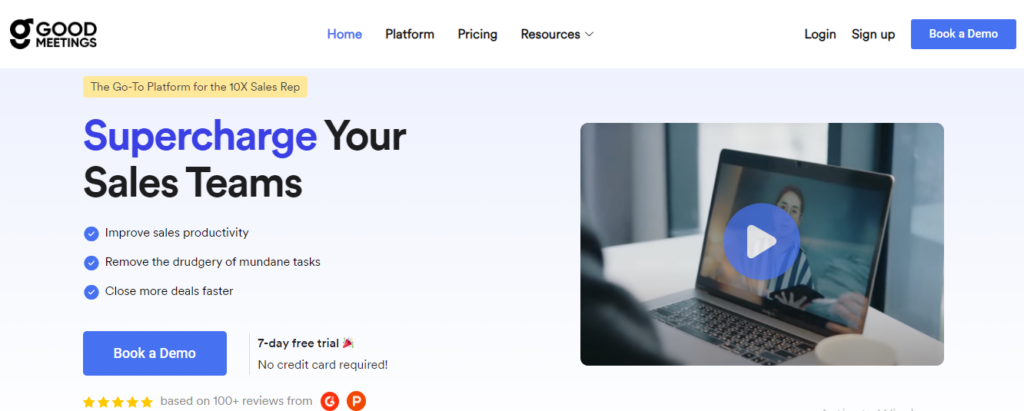
Source: Goodmeetings
As discussed above, using the right tools is important to increase sales SaaS sales.
One such tool you can use is – Goodmeetings!
It is an AI-powered SaaS tool that helps record, transcribe, summarize and analyze all your virtual sales conversations. With Goodmeetings, you can
- Automate mandate note-taking and CRM data entry tasks.
- Create a database of all your important sales conversations.
- Coach and train your sales reps to improve their performance and productivity.
- Analyze your sales conversations to create and improve your sales strategies.
- Track and measure the performance of your sales reps, sales pitch and sales meetings.


Source: Goodmeetings
There’s a lot more you can do with Goodmeetings. Let’s take a look at its key features:
- Call Recording
Capture every word with AI-driven call recording technology, ensuring comprehensive records of every sales interaction.
- High-Quality Transcriptions
Turn conversations into searchable text with high-precision transcriptions, making meeting insights readily accessible.
- Call Analytics
Glean valuable metrics from your call data, identifying trends and areas for improvement in sales communications.
- Multi-language Support
Engage globally with multi-language support, ensuring clear communication across diverse markets.
- Video Meeting Library
Build a searchable library of video meetings, archiving valuable visual interactions for training and review.
- Automation
Enhance meeting efficiency with automation tools that generate action items, human-level summaries, and meeting performance insights.
- Customized Reporting Dashboards
Personalize how you view and analyze meeting data with customizable dashboards tailored to your priorities.
- Deep CRM Integration
Seamlessly connect meeting insights with your CRM, enriching customer profiles and sales strategies.
- AI-generated Key Moments
AI pinpoints and highlights the most critical moments in meetings, helping you focus on the turning points that matter.
- AI-powered Sales Battlecards
Equip your sales team with AI-powered battlecards that provide real-time insights and suggestions during customer interactions.
- Live Incognito Coaching
Enable live incognito coaching during sales calls, helping them navigate complex situations and improve performance on the spot.
- Ask Me Anything
Stay informed and prepared for follow-ups by accessing instant insights from past interactions.
- Sentiment Analytics
Adjust your approach dynamically by understanding client sentiment, leading to more empathetic engagements and successful closes.
- Screenshare Analytics
Sharpen your presentations by understanding what content keeps clients engaged, helping to steer the conversation towards deal closure.
Goodmeetings simplifies meetings, optimizes sales processes, and ensures seamless collaboration through its advanced AI-powered features. It is an all-in-one platform to improve your overall sales productivity and revenue.
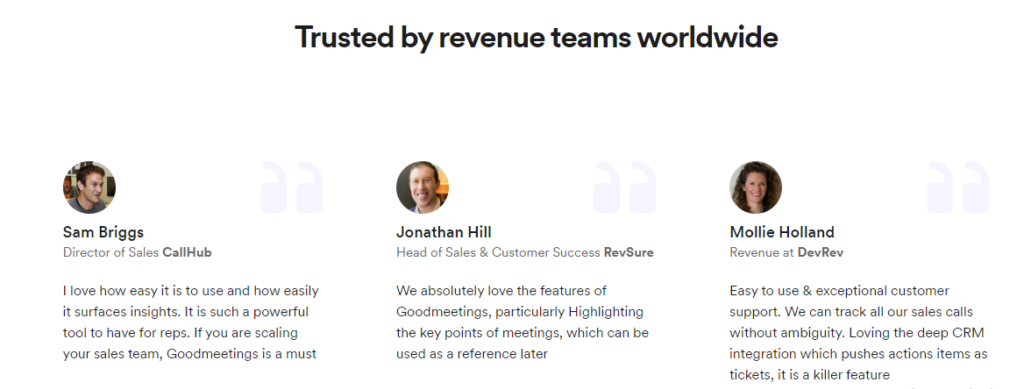
Source: Goodmeetings
Want to see how Goodmeetings can increase the sales of your SaaS product? Sign up for free and enjoy a 7-day free trial or book a free demo.

